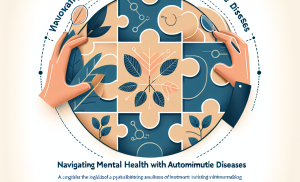Creative And Non-traditional Therapies That Have Improved Mental Health
Have you ever wondered about the innovative ways people are finding to improve mental health? There are a number of creative and non-traditional therapies and treatments that have shown great promise in addressing mental health issues. From art and music therapy to equine-assisted therapy and mindfulness practices, these alternative approaches offer unique and engaging ways to enhance mental well-being. In this article, we will explore some of these intriguing therapies and treatments that are making a positive impact on mental health. So, grab a cup of tea, sit back, and let’s dive into the world of unconventional methods that can help improve mental health.

Music Therapy
Definition and Approach
Music therapy is a form of therapy that utilizes the power of music to improve mental health and well-being. It involves the use of music, either listening to it or engaging in musical activities, as a means of promoting emotional expression, reducing stress, and enhancing cognitive abilities. The approach of music therapy is based on the understanding that music has the ability to elicit emotional responses, stimulate memories, and promote relaxation.
Benefits for Mental Health
Music therapy has been found to provide numerous benefits for mental health. One of the key benefits is its ability to reduce anxiety and stress. Listening to calming music or engaging in musical activities can help individuals relax and alleviate feelings of tension. It can also help in improving mood and enhancing emotional well-being. Music therapy has shown to be particularly effective in reducing symptoms of depression and promoting a more positive outlook.
In addition, music therapy can also improve cognitive abilities, such as attention, memory, and verbal skills. Research has shown that engaging in musical activities can stimulate various areas of the brain, leading to enhanced cognitive functioning. This can be especially beneficial for individuals with neurodevelopmental disorders or cognitive impairments.
Furthermore, music therapy has been found to be effective in treating individuals with trauma-related disorders, such as post-traumatic stress disorder (PTSD). Listening to or creating music can help individuals process traumatic experiences and alleviate symptoms associated with trauma.
Evidence and Research
Numerous studies have shown the effectiveness of music therapy in improving mental health. For example, a meta-analysis conducted by Gold et al. (2014) found that music therapy had a moderate to large effect in reducing symptoms of depression and anxiety. Another study by Kemper (2017) found that music therapy was effective in improving self-esteem and emotional well-being in individuals with neurological conditions.
Furthermore, music therapy has been recognized as an evidence-based practice by various professional organizations, including the American Music Therapy Association and the National Institute for Health and Care Excellence. These organizations have acknowledged the therapeutic benefits of music therapy and have recommended its use in various healthcare settings.
Overall, music therapy offers a therapeutic and creative approach to improving mental health. By harnessing the power of music, individuals can experience emotional expression, stress reduction, cognitive enhancement, and overall improvement in their mental well-being.
Art Therapy
Overview of Art Therapy
Art therapy is a form of therapy that utilizes various art forms, such as drawing, painting, and sculpting, as a means of promoting self-expression and emotional healing. It is based on the belief that the process of creating art can be therapeutic and can help individuals explore their thoughts, emotions, and experiences in a non-verbal and creative manner.
Methods and Techniques
Art therapy employs various methods and techniques to facilitate the therapeutic process. These may include guided imagery, where individuals are asked to visualize a specific scene or situation and then create a corresponding artwork. Another technique often used in art therapy is mandala drawing, where individuals create repetitive patterns within a circular framework, which can promote relaxation and focus.
Furthermore, art therapy may also involve the use of collage, where individuals create artworks by combining various materials, such as magazine cutouts and photographs. This technique can help individuals explore different aspects of their identity and experiences.
Effectiveness in Mental Health
Research has shown that art therapy can be effective in improving mental health and well-being. A study conducted by Stuckey and Nobel (2010) found that engaging in art activities led to significant improvements in psychological well-being, including reductions in anxiety and increased positive emotions.
Art therapy has also been found to be particularly beneficial for individuals with trauma-related disorders. The creative process of making art can help individuals process traumatic experiences and promote healing. Research has shown that art therapy can reduce symptoms of trauma-related disorders, such as intrusive thoughts and nightmares.
Furthermore, art therapy has been used successfully in the treatment of various mental health conditions, including depression, eating disorders, and substance abuse. It provides individuals with a non-verbal and creative outlet for expressing their emotions and experiences, which can be especially beneficial for those who struggle with verbal communication.
In conclusion, art therapy offers a unique and creative approach to improving mental health. By engaging in artistic activities, individuals can explore their emotions, promote self-expression, and experience healing and personal growth.
Equine Therapy
Concept and Purpose
Equine therapy, also known as horse therapy or horse-assisted therapy, is a therapeutic approach that involves the interaction and connection between individuals and horses. The concept behind equine therapy is that horses have the ability to provide emotional support, promote trust and empathy, and facilitate personal growth and self-awareness.
The purpose of equine therapy is to address psychological, emotional, and behavioral issues through the therapeutic use of horses. It can be particularly beneficial for individuals with conditions such as autism, ADHD, anxiety, and depression. Equine therapy provides a unique and experiential approach to therapy, where individuals can learn and grow through their interaction with horses.
Therapeutic Activities with Horses
Equine therapy incorporates a range of therapeutic activities involving horses. These activities may include grooming and bonding exercises, where individuals spend time with the horses, developing a sense of trust and connection. Riding and horsemanship activities can also be part of equine therapy, allowing individuals to develop skills and confidence while interacting with the horses.
Another therapeutic activity often used in equine therapy is groundwork, where individuals work with the horses on the ground, guiding them through various exercises. This can help develop communication and leadership skills, as well as promote emotional regulation and self-esteem.
Impact on Mental Health
Research has shown that equine therapy can have a positive impact on mental health and well-being. Interacting with horses has been found to reduce stress levels and promote relaxation. The presence of horses can have a calming effect on individuals, helping them feel more grounded and centered.
Equine therapy has also been shown to improve social skills and emotional regulation. By working with the horses, individuals can develop empathy, trust, and effective communication skills. These skills can then transfer to other areas of their lives and relationships.
Furthermore, equine therapy can provide individuals with a sense of purpose and accomplishment. Taking care of and working with horses can boost self-confidence and self-esteem. It allows individuals to experience a sense of achievement and competence, which can be especially beneficial for those struggling with low self-worth.
In conclusion, equine therapy offers a unique and powerful approach to improving mental health. Through the therapeutic interaction with horses, individuals can develop emotional skills, improve social functioning, and experience personal growth and healing.
Dance/Movement Therapy
Introduction to Dance/Movement Therapy
Dance/movement therapy is a form of therapy that integrates the body, mind, and emotions through movement and dance. It recognizes the deep connection between movement and emotions and utilizes this connection to promote self-expression, release tension, and explore and process emotions.
Dance/movement therapy is based on the belief that movement and dance can serve as a powerful medium for individuals to access and express their inner world. It can be particularly beneficial for those who struggle with verbal communication or find it difficult to express their emotions in words.
Techniques and Modalities
Dance/movement therapy incorporates various techniques and modalities to facilitate the therapeutic process. These may include improvisational dance, where individuals are encouraged to move freely and expressively, without any set choreography. This allows for spontaneous and authentic movement, which can promote emotional expression and release.
Group dance/movement therapy is another modality often utilized, where individuals engage in movement and dance in a group setting. This can foster a sense of connection and support, as well as provide opportunities for sharing and reflection.
Positive Effects on Mental Health
Research has shown that dance/movement therapy can have positive effects on mental health and well-being. It has been found to reduce symptoms of anxiety and depression, as well as improve body image and self-esteem.
The embodied nature of dance/movement therapy allows individuals to connect with their body and emotions in a unique way. By moving and expressing themselves through dance, individuals can release tension and stress, and experience a greater sense of well-being.
Furthermore, dance/movement therapy can enhance self-awareness and emotional regulation. Through the exploration of movement and dance, individuals can gain insights into their patterns of behavior and emotions. This increased self-awareness can lead to personal growth and improved mental health outcomes.
In conclusion, dance/movement therapy offers a dynamic and expressive approach to improving mental health. By engaging in movement and dance, individuals can access and process their emotions, promote self-expression, and experience healing and transformation.

Virtual Reality Therapy
Explanation of Virtual Reality Therapy
Virtual reality therapy (VRT) is a therapeutic approach that involves the use of virtual reality technology to create simulated environments. This technology immerses individuals in computer-generated environments, allowing them to have interactive and realistic experiences.
VRT can be used to treat various mental health conditions, such as anxiety disorders, phobias, and PTSD. It provides a safe and controlled environment for individuals to confront and overcome their fears and anxieties.
Applications and Advantages
VRT has a wide range of applications in mental health treatment. It can be used in exposure therapy, where individuals are gradually exposed to stimuli that trigger their anxiety or phobias. Through repeated exposures in the virtual environment, individuals can desensitize themselves to the feared stimuli and reduce their anxiety response.
Another application of VRT is in pain management. The immersive and interactive nature of virtual reality can distract individuals from their pain and provide a sense of relief. VRT has been used successfully in the treatment of chronic pain and has shown promising results in reducing pain intensity and improving overall well-being.
Furthermore, VRT can be used in cognitive-behavioral therapy (CBT), where individuals can practice and apply cognitive and behavioral skills in a virtual environment. This allows for realistic and practical learning experiences, which can enhance the effectiveness of therapy.
Efficacy in Mental Health Improvement
Research has demonstrated the efficacy of virtual reality therapy in improving mental health outcomes. Studies have shown that VRT can significantly reduce symptoms of anxiety disorders and phobias. The immersive nature of virtual reality provides individuals with a realistic and engaging environment to confront their fears, which can lead to lasting improvements in anxiety symptoms.
VRT has also been found to be effective in reducing symptoms of PTSD. Virtual reality exposure therapy allows individuals to gradually and safely confront traumatic memories, facilitating the processing and integration of the traumatic experience. This can lead to a reduction in PTSD symptoms, such as flashbacks and nightmares.
Additionally, VRT has been shown to be effective in pain management. Studies have found that virtual reality can reduce pain intensity and improve overall well-being in individuals with chronic pain.
In conclusion, virtual reality therapy offers a novel and powerful approach to improving mental health. Through the use of immersive technology, individuals can confront fears, manage pain, and acquire new skills, leading to improved mental well-being.
Yoga and Mindfulness
Introduction to Yoga and Mindfulness
Yoga and mindfulness are practices that have been used for centuries to promote mental and physical well-being. Yoga combines physical postures, breathing exercises, and meditation, while mindfulness involves paying attention to the present moment with non-judgmental awareness.
Both yoga and mindfulness are rooted in the belief that the mind and body are interconnected and that by cultivating awareness and presence, individuals can experience greater peace and well-being.
Techniques and Practices
Yoga encompasses a variety of techniques and practices. This may include physical postures (asana), which promote strength, flexibility, and balance. Breathing exercises (pranayama) can also be part of yoga practice and are used to calm the mind and energize the body.
Mindfulness, on the other hand, involves practices such as meditation, where individuals cultivate present moment awareness. This can be done through focusing on the breath, body sensations, or simply observing thoughts and emotions without judgment.
Benefits for Mental Health
Research has shown that both yoga and mindfulness can have numerous benefits for mental health. Regular practice of yoga and mindfulness has been found to reduce symptoms of anxiety and depression. The mind-body connection fostered through these practices can help individuals regulate their emotions, reduce stress, and improve overall well-being.
Furthermore, yoga and mindfulness have been shown to enhance cognitive functioning. Regular practice can improve attention, concentration, and memory. The meditative aspect of these practices can also lead to increased self-awareness and insight into one’s thoughts and emotions.
In addition, yoga and mindfulness can promote relaxation and improve sleep quality. The deep breathing and relaxation techniques used in these practices can help individuals calm their nervous system and improve their ability to relax and rest.
In conclusion, yoga and mindfulness provide individuals with practical tools and techniques to promote mental and physical well-being. By integrating movement, breath, and mindfulness, individuals can experience reduced anxiety and depression, improved cognitive functioning, and overall enhanced mental health.

Adventure Therapy
Definition and Approach
Adventure therapy is a therapeutic approach that utilizes outdoor activities and adventure-based experiences to promote personal growth and improve mental health. It provides individuals with opportunities to engage in challenging and novel experiences, which can facilitate the development of skills such as problem-solving, teamwork, and self-efficacy.
The approach of adventure therapy is grounded in the belief that nature and adventure can serve as catalysts for personal change and healing. By stepping out of their comfort zones and engaging in outdoor activities, individuals can gain new perspectives, build resilience, and develop a sense of empowerment.
Outdoor Activities in Therapy
Adventure therapy incorporates a wide range of outdoor activities to facilitate the therapeutic process. These may include rock climbing, hiking, camping, kayaking, and team-building exercises. The choice of activities depends on the goals and needs of the individuals participating in therapy.
Outdoor activities can provide individuals with a sense of adventure and challenge, as well as create opportunities for reflection and personal growth. The natural environment offers a unique setting for therapy, allowing individuals to connect with nature, experience awe, and gain a sense of perspective.
Promising Results in Mental Health
Research has shown promising results in using adventure therapy to improve mental health. Studies have found that adventure therapy can lead to reductions in symptoms of anxiety, depression, and stress. It can also enhance self-esteem and self-efficacy, as individuals overcome challenges and develop new skills.
Adventure therapy has been found to be particularly effective for individuals with substance use disorders, as it provides a healthy and engaging alternative to addictive behaviors. Outdoor activities can promote a sense of self-worth and build resilience and coping skills, which can support individuals in their recovery journey.
Furthermore, adventure therapy has shown to be beneficial for individuals with behavioral and emotional difficulties, such as ADHD and conduct disorders. The experiential nature of adventure therapy allows individuals to practice skills such as impulse control, problem-solving, and social interaction in a real-life context.
In conclusion, adventure therapy offers an innovative and holistic approach to improving mental health. By engaging in outdoor activities and adventure-based experiences, individuals can develop resilience, enhance self-esteem, and experience personal growth and transformation.
Animal-Assisted Therapy
Overview of Animal-Assisted Therapy
Animal-assisted therapy (AAT) is a therapeutic approach that involves the use of animals to promote emotional and physical healing. AAT recognizes the positive impact that animals can have on individuals’ well-being and utilizes this connection to enhance the therapeutic process.
Animals used in AAT can include dogs, cats, horses, and even dolphins. These animals are carefully selected and trained to provide support, comfort, and companionship to individuals undergoing therapy. They can help create a safe and non-judgmental space for individuals to express their emotions and build trust.
Different Animal Companions
Different animals can provide distinct therapeutic benefits in animal-assisted therapy. Dogs, for example, are often used for their ability to provide unconditional love and companionship. They can help reduce feelings of loneliness and anxiety and promote relaxation. Cats, on the other hand, are known for their calming presence and can help individuals regulate their emotions and reduce stress.
Horses are frequently used in equine-assisted therapy, as they can serve as powerful metaphors for individuals’ emotions and experiences. Interacting with horses can promote emotional regulation, empathy, and trust. Dolphins, with their playful and social nature, are sometimes used in therapy settings to promote joy and connection.
Positive Impact on Mental Health
Animal-assisted therapy has shown to have a positive impact on mental health and well-being. Interacting with animals can trigger the release of oxytocin, a hormone associated with bonding and relaxation. This can lead to reduced stress and improved mood.
Furthermore, animals can provide a unique source of emotional support and comfort. The presence of an animal companion can help individuals feel less alone and more connected. They can provide a non-judgmental space for individuals to express their emotions and process their experiences.
Animal-assisted therapy has been found to be particularly beneficial for individuals with trauma-related disorders. The non-threatening and supportive presence of animals can help individuals feel safe and secure, promoting healing and emotional regulation.
In conclusion, animal-assisted therapy offers a compassionate and nurturing approach to improving mental health. By engaging with animals, individuals can experience emotional support, connection, and healing.

Expressive Writing Therapy
Explanation of Expressive Writing Therapy
Expressive writing therapy is a therapeutic approach that involves the use of written expression to promote emotional healing and improve mental health. It provides individuals with a structured and safe outlet for exploring their thoughts, emotions, and experiences.
Expressive writing therapy typically involves writing about traumatic or emotionally challenging events for a designated period of time, usually 20-30 minutes. The emphasis is on the process of writing rather than the outcome, allowing individuals to freely express their emotions without judgment.
Techniques and Practices
Expressive writing therapy incorporates various techniques and practices to facilitate the therapeutic process. These may include journaling, where individuals write about their thoughts and feelings on a regular basis. Therapeutic letter writing, where individuals write letters to themselves or others as a means of processing emotions and gaining insights, is another technique used in expressive writing therapy.
Furthermore, prompts and guided exercises can be provided to help individuals explore specific themes or emotions. For example, individuals may be asked to write about a traumatic event or reflect on their values and aspirations.
Improvement of Mental Health Symptoms
Research has shown that expressive writing therapy can lead to improvements in mental health symptoms. Studies have found that engaging in expressive writing can reduce symptoms of depression and anxiety, as well as improve overall well-being.
Expressive writing therapy has also been found to have physical health benefits. It has been shown to boost immune system functioning and improve sleep quality. Writing about traumatic experiences can also lead to reductions in cortisol, a stress hormone, thereby promoting stress reduction and relaxation.
Additionally, expressive writing therapy has shown promising results in individuals with trauma-related disorders. Writing about traumatic events can facilitate the processing and integration of the traumatic experience, leading to reduced symptoms of post-traumatic stress disorder (PTSD).
In conclusion, expressive writing therapy offers a powerful and accessible approach to improving mental health. By engaging in written expression, individuals can explore their thoughts and emotions, gain insights, and experience healing and growth.
Laughter Therapy
Concept and Purpose
Laughter therapy, also known as laughter yoga, is a therapeutic approach that utilizes laughter as a means of improving mental health and well-being. It recognizes the healing power of laughter and aims to create an environment where individuals can experience laughter and its associated benefits.
The purpose of laughter therapy is to promote relaxation, stress reduction, and emotional release. It provides individuals with an opportunity to engage in laughter exercises and activities, even in the absence of humor or comedy.
Methods and Techniques
Laughter therapy incorporates various methods and techniques to facilitate the therapeutic process. These may include laughter exercises, where individuals engage in deliberate and prolonged laughter, often in a group setting. These exercises can involve playful activities, such as pretending to laugh or engaging in exaggerated laughter.
Laughter meditation is another technique used in laughter therapy. Individuals are guided to focus on the sensation of laughter within their bodies, allowing them to experience the physical and emotional benefits of laughter.
Benefits for Mental Health
Laughter therapy has been found to provide numerous benefits for mental health. Laughter triggers the release of endorphins, the body’s natural feel-good chemicals, which can promote a sense of well-being and reduce pain.
Furthermore, laughter therapy can reduce stress and improve emotional well-being. Laughter has been shown to lower cortisol levels, a stress hormone, and increase dopamine levels, a neurotransmitter associated with pleasure and reward. This can result in a reduced stress response and an enhanced mood.
Laughter therapy has also been found to strengthen social connections and improve relationships. Laughter is contagious and can create a sense of shared joy and connection. Engaging in laughter exercises and activities in a group setting can foster a sense of belonging and support.
In conclusion, laughter therapy offers a lighthearted and engaging approach to improving mental health. By engaging in laughter exercises and activities, individuals can experience stress reduction, improved emotional well-being, and enhanced social connections.
In conclusion, there are several creative and non-traditional therapies that have shown promise in improving mental health. Music therapy, art therapy, equine therapy, dance/movement therapy, virtual reality therapy, yoga and mindfulness, adventure therapy, animal-assisted therapy, expressive writing therapy, and laughter therapy all offer unique approaches to promoting mental health and well-being. Each therapy utilizes different techniques and modalities to engage individuals in a therapeutic process that fosters self-expression, emotional healing, and personal growth. Research has demonstrated the effectiveness of these therapies in reducing symptoms of anxiety, depression, and trauma-related disorders, as well as improving cognitive functioning and overall well-being. Whether through the power of music, the creativity of art, the connection with animals, or the liberation of laughter, these therapies offer individuals innovative and holistic approaches to improving their mental health.


















